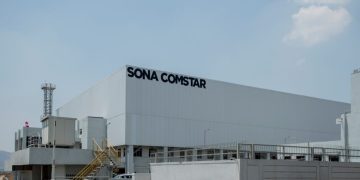We’ve known for decades that where technology is concerned, the more uptake a product or commodity has the more its price reduces which creates exponential growth as more people can afford to buy in. What I’m currently finding interesting is that we seem to have the same phenomenon happening within our industry, which helps collision repairers become more and more sustainable. Whereas in the past, even in my everyday life, I’ve always thought that most products developed with the intention of increasing sustainability appeared to be almost prohibitively expensive yet now this seems to be changing. Given the headwinds repairers in all regions currently face, from energy prices to waste disposal costs and even with the global labour shortages is it time to start leaning on more sustainable products and portfolios in an effort to make collision repair shops more profitable or is this just wishful thinking?
At the beginning of my career, I witnessed the introduction of waterborne base coats into the UK collision repair industry and watched as painters and paint staff in the large facility I was working screwed their faces up and resisted the move toward this lower VOC technology. As the months went by those same paint shop staff learned to work with the new technology and grew to embrace the change almost unconsciously, nobody knew the change was happening given how slowly the process was, yet we arrived at a point where the changeover was accepted. Fast forward 20 years and I see the same facial expressions on the faces of painters and hear the same arguments pushing back on new and emerging low-energy or fast-curing clear coats and primers. With an open-minded attitude, I have been lucky enough to test some of the air dry, UV curing, and low energy coatings that are slowly emerging into the ANZ collision repair industry and have to admit that I have been impressed. Remove any preconceived ideas about the longevity, UV stabilisation, or gloss retention of low-energy clear coats and you will soon start to realise that the effort put into these coatings by each paint manufacturer has resulted in a huge leap forward in this technology. From my perspective, and without carrying out exhaustive trialling, these types of clear coats could not only be a consideration for SMART repair facilities but could be a consideration for all collision repairers. The ability to bake a vehicle at a third of the temperature or a fraction of the time and still have a fully cured coating at the end was mind-blowing to me when I first learned about the technology, and now having spent some time carrying out paint rectification on clear coats applied literally minutes before sanding I struggle to see a downside even with a slight increase in the ready for use cost, this additional cost will be returned many times over when all costs are factored in, truly an example of sustainability becoming more cost-effective?
Unlike low-energy coatings, UV technology appears to be more widely accepted, and we continually see more and more developments in these coatings. Of course, the limits of these coatings, especially primers, will naturally be pushed in a real-world situation which could lead to failure or rework but used correctly UV fillers and primers especially can dramatically reduce key-to-key times in a repair shop and remove the need to bake a typical high build primer for a fast repair facility. In terms of improving a shop’s sustainability rating UV technology, in my view, can only be a benefit when utilising UV to replace the likes of Infrared (IR) or gas-powered curing techniques, however, the benefit is still very real and UV can be a very cost-effective way to not only improve repair times but also reduce energy usage even given the cost of the technology involved in the curing process.
Maybe those same paint shop technicians I worked with at the start of my career would screw their faces up today and push back just as hard if we changed their paint system out and turned their booth temperatures down just like they did years ago, but I would like to think that just the same result would happen today and slowly but surely they would embrace the change and learn to love their new way of working and the technology involved.
Much like the coatings available to a modern collision repairer the technology behind the Paint Application Systems (PAS) has improved at an impressive rate too in recent years. Nobody working in the industry will have missed the introduction of the Paint Preparation System (PPS) which now has many versions and iterations from various manufacturers, it is hard to believe it was almost 20 years ago that this system was introduced and literally changed the entire industry.
A PPS system with its recyclable lids and liners not only saves a lot of the messy clean-up of spray equipment but enables paint shops to reduce the hazards and costs associated with the use and storage of waste gun wash while keeping their paint staff more productive, saving labour in clean up times, it’s a win–win situation. Further to this, when you utilise an aerosol gun cleaning solvent to clean through your spray equipment you completely eradicate the costs of waste gun wash disposal services, all of this adds up to the fact that while adding slightly to the cost of a business these PPS systems dramatically increase productivity and profitability in the long term, all while having the added benefit of being highly sustainable when used correctly.
However the biggest leap forwards in PAS technology has to be the development of High Transfer Efficiency spray guns, name any spray gun manufacturer and the likelihood is they will have developed some type of High Transfer Efficiency (HTE) spray gun or air cap. Devilbiss have their High-Efficiency air cap, Sata are well known for their Reduced Pressure or RP, even the likes of Iwata and Walcom have HTE versions available. To add to the invention of PPS, 3M has developed a new Spray Gun that during independent testing has shown the highest transfer efficiency rating in spray equipment available today. Now in a post covid world when we look at the increasing costs of paint and coatings due to raw materials and shipping challenges the ability to invest in some of this HTE technology can have a dramatic effect on a paint shop’ bottom line, not only will a higher transfer efficiency allow for less material wastage, therefore, reducing a shops paint bills but without clouds of overspray there are secondary benefits such as less booth maintenance and downtime as filters and booth coatings will require less changing ultimately resulting in less waste produced by a paint shop.
The paint shop is not the only area of a modern collision repair facility that can see productivity benefits while simultaneously decreasing their environmental impact, paint and panel shops alike can now see huge benefits in productivity simply by being aware of the performance benefits of premium grade abrasives. For many years now shops have been tempted by the lure of cheaper consumables, often the distributors’ way of distracting from paint costs rising or in an effort to please a shop owner. Yet is it now time to ask if cheaper is not actually that cheap after all?
Take a simple abrasive disc for example, Although not primarily a sustainability-increasing product any consumable that has the ability to reduce a shop’s waste must be seen as having an environmental benefit. If a budget disc works out at half the cost of the premium alternative but lasts a third of the time then simply by purchasing the cheaper discs the shop is costing themselves money at the point of purchase and when disposing of waste right? And to those who argue that their staff doesn’t use a disc until its end of life, what do we say to this argument? Well, I find it simple, a premium abrasive will normally cut faster than a budget disc meaning that when labour rates are factored in, a simple 2-minute sanding operation may end up costing a shop owner an extra minute or more of labour, simply by choosing a cheaper disc, add into this the down time to swap out worn out discs and the extra waste disposal costs, the minuscule savings at the point of purchase are by far outweighed by the extra costs in reality. It seems simple really, but the cost analysis involved in testing an abrasive disc’s performance against another is one that is often not used when choosing what abrasives to use in a shop, but it is starting to be used by forward-thinking shop owners and MSO’s who place productivity and profitability high on their agenda. The hidden benefits of moving towards more premium abrasives ranges are the modern process improvements that become available. By moving away from older wet or dry papers and wet flatting techniques in both paint prep and paint finishing, modern paint shops can not only reduce potential reworks and failures but also remove the need for costly and time-consuming clean-up operations leaving technicians more time to be productive ultimately leading to more profit!
In summary, there are many new and emerging technologies available in coating systems, paint delivery systems and consumables that will not only benefit collision repairers financially but also help improve their environmental impact. Some solutions may not immediately come across as having a sustainability benefit whereas some solutions such as low energy or air dry clear coats and primers are purely born out of the need to reduce carbon emissions, this does not mean that certain solutions don’t have an environmental benefit, maybe it’s just the case that the marketing department hasn’t seen that yet, nevertheless any sustainability increase in collision repair cannot be overlooked if we do want a bright future for our industry, especially when that increase coincides with an increase in productivity and profit.

Collision Repair Specialist
Educator
3M



























































